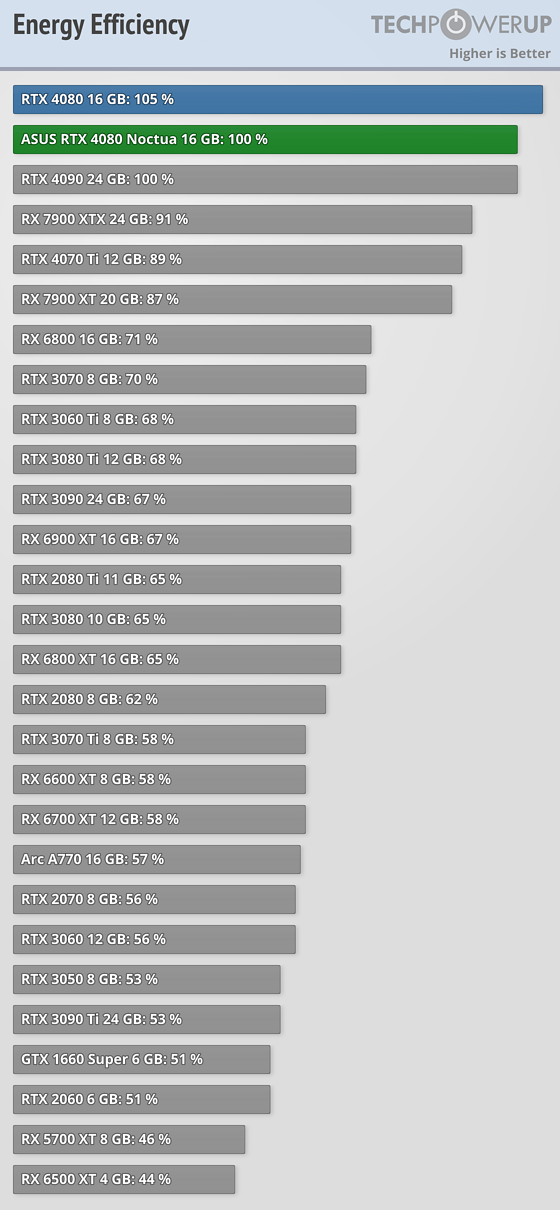 69
69
ASUS GeForce RTX 4080 Noctua OC Review - Next-Level Quiet
Overclocking & Power Limits »Energy Efficiency
Energy Efficiency calculations are based on measurements using Cyberpunk 2077. We record power draw and FPS rate to calculate the energy efficiency of the graphics card as it operates.

Voltage Frequency Curve
The card will dynamically adjust clocks and voltage based on render load, temperature, and other factors.For the graph below, we recorded all GPU clock and GPU voltage combinations of our 1440p resolution benchmarking suite. The plotted points are transparent, which allows them to add up to indicate more often used values. A light color means the clock and voltage combination is rarely used, and a dark color means it's active more often. The minimum and maximum values are 99th and 1st percentile, so outliers are excluded.

Clock States
| Clock Frequencies & Voltage | |||
|---|---|---|---|
| GPU Clock | Memory Clock | GPU Voltage | |
| Idle | 210 MHz | 51 MHz | 0.945 V |
| Multi-Monitor | 210 MHz | 51 MHz | 0.945 V |
| Video Playback | 210 MHz | 51 MHz | 0.945 V |
| Furmark | 1745 MHz 1695 to 2025 MHz | 1400 MHz | 0.925 V 0.925 to 0.935 V |
| Gaming (Cyberpunk 2077) | 2865 MHz 2850 to 2880 MHz | 1400 MHz | 1.065 V 1.050 to 1.075 V |
| Ray Tracing (Cyberpunk 2077) | 2825 MHz 2790 to 2850 MHz | 1400 MHz | 1.031 V 1.010 to 1.050 V |
| V-Sync (Cyberpunk 2077) | 1058 MHz 1050 to 1065 MHz | 625 MHz | 0.934 V 0.930 to 0.935 V |
| Gaming (25 Games) | 2862 MHz 2595 to 2895 MHz | 1400 MHz | 1.031 V 0.925 to 1.075 V |
Feb 4th, 2025 03:36 EST
change timezone
Latest GPU Drivers
New Forum Posts
- Your PC ATM (35217)
- Dell Workstation Owners Club (3279)
- QVL - Myth, Legend, Marketing/Advertising, what is your take? (94)
- RTX5000 Series Owners Club (40)
- RTX 5080 - premature review - it sucks (317)
- Is It The 1080 TI The Best GPU Ever? (252)
- Help:Pc suddenly shut down, Now can’t turn on (1)
- NVCleanstall doesn't install NVIDIA Control Panel (10)
- GPU hotspot and Gpu tem differences (11)
- Will you buy a RTX 5090? (402)
Popular Reviews
- Spider-Man 2 Performance Benchmark Review - 35 GPUs Tested
- Corsair Frame 4000D Review
- NVIDIA GeForce RTX 5080 Founders Edition Review
- MSI GeForce RTX 5080 Vanguard SOC Review
- Gigabyte GeForce RTX 5080 Gaming OC Review
- ASUS GeForce RTX 5080 Astral OC Review
- Cooler Master X Silent Edge Platinum 850 W Review - Fully Passive PSU
- MSI GeForce RTX 5080 Suprim SOC Review
- NVIDIA DLSS 4 Transformer Review - Better Image Quality for Everyone
- AMD Ryzen 7 9800X3D Review - The Best Gaming Processor
Controversial News Posts
- NVIDIA 2025 International CES Keynote: Liveblog (470)
- AMD Debuts Radeon RX 9070 XT and RX 9070 Powered by RDNA 4, and FSR 4 (349)
- AMD Radeon 9070 XT Rumored to Outpace RTX 5070 Ti by Almost 15% (274)
- AMD is Taking Time with Radeon RX 9000 to Optimize Software and FSR 4 (256)
- AMD Denies Radeon RX 9070 XT $899 USD Starting Price Point Rumors (239)
- Edward Snowden Lashes Out at NVIDIA Over GeForce RTX 50 Pricing And Value (233)
- AMD Radeon RX 9070 XT & RX 9070 Custom Models In Stock at European Stores (226)
- New Leak Reveals NVIDIA RTX 5080 Is Slower Than RTX 4090 (215)